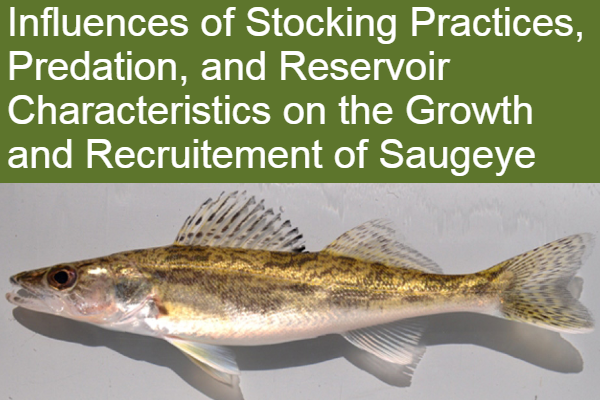Budnik, Marschall publish Saugeye paper in NAJFM

Drs. Rich Budnik and Libby Marschall along with AEL alum Jahn Kallis recently published a paper titled, "Influence of Stocking Practices, Predation, and Reservoir Characteristics on the Growth and Recruitment of Saugeye" in the North American Journal of Fisheries Management.
Budnik, R.R., J.L. Kallis, E.A. Marschall. 2021. Influence of Stocking Practices, Predation, and Reservoir Characteristics on the Growth and Recruitment of Saugeye. North American Journal of Fisheries Management. doi.org/10.1002/nafm.10624
Abstract
Saugeye (female Sander vitreus X male S. canadensis) are stocked annually into Ohio reservoirs to maintain popular recreational fisheries. The growth and recruitment of stocked saugeye are highly variable among years and reservoirs, with the causes of this variability not well understood. Using a multi-year (2004-2019), multi-reservoir (6 reservoirs) dataset, we implemented mixed-effects models and an information theoretic approach to identify possible predictors of saugeye post-stocking growth and recruitment. Top-performing models (ΔAICc < 2) explained 38-40% of the variation in stocked saugeye growth (N = 4 models) and 36-47% of the variation in stocked saugeye recruitment (N = 9 models). Specifically, our growth models identified stocking day of year and mean summer (July-August) water temperature as significant predictors, with saugeye experiencing higher daily growth rates when fish were stocked earlier in the year and when summer water temperatures were warmer. Based on the results from our recruitment models, stocking density was identified as the only significant predictor, with greater stocking densities leading to stronger stocked saugeye recruitment. From these relationships, we predict that saugeye fishery production will be greater when managers stock greater densities of saugeye earlier in the year and when summer reservoir temperatures are higher. Despite identifying significant predictors, our models could not explain much of the variation in stocked saugeye growth and recruitment, revealing the complexity of growth and recruitment processes in Ohio reservoirs.
